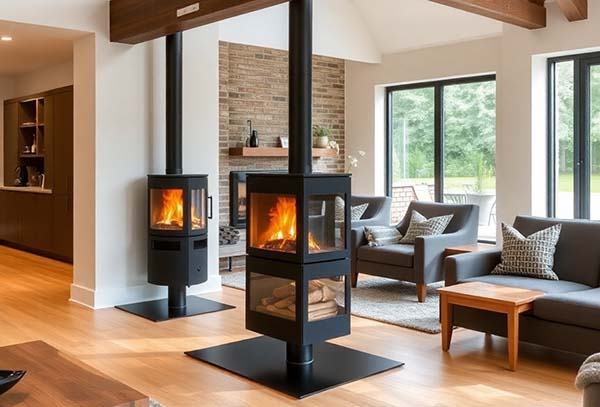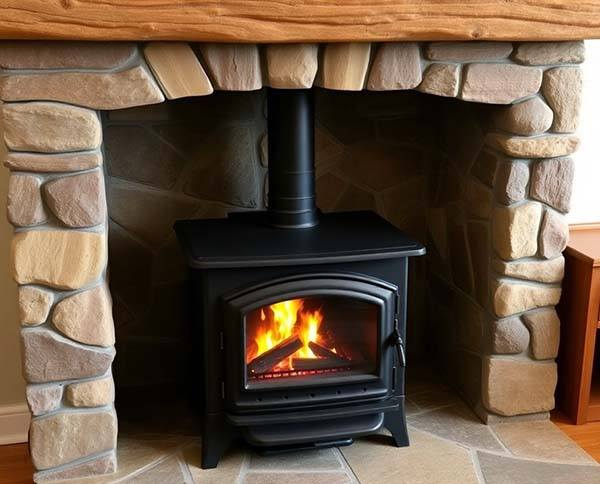Expert Tips for Dorset Homes
By Wes Dodd, WD Wood Burner Installations – Poole, Bournemouth & Dorset
Installing a log burner is one of the best decisions you can make for your home. Not only does it create a warm, cosy focal point, but it also helps reduce reliance on central heating.
But here’s the thing – if you don’t use your log burner properly, you could be wasting heat, spending more on logs, and putting unnecessary strain on your stove.
As a HETAS-approved wood burner installer in Poole, Bournemouth, and Dorset, I’ve fitted countless stoves and helped homeowners get the very best out of them. Here are my top tips to maximise efficiency, save money, and keep your log burner in great condition.
1. Use the Right Wood
The type of wood you burn is the single biggest factor in performance. Always choose:
- Seasoned or kiln-dried hardwoods like oak, ash, or beech.
- Logs with moisture content below 20% (check with a moisture meter).
Burning wet or unseasoned logs wastes energy boiling off water, creates excess smoke, and clogs up your chimney.
2. Light Fires the Smart Way
Avoid firelighters that leave chemical smells. Instead:
- Use softwood kindling or small dry sticks to get the fire going.
- Build a “top-down fire” – place larger logs at the bottom and kindling on top, then light from above. This method gives a cleaner burn with less smoke.
3. Control the Air Supply
Most stoves in Dorset homes have adjustable air vents.
- Start with vents open to get the fire established.
- Once it’s burning well, reduce airflow for a slower, more efficient burn.
- Avoid slamming the vents shut – this starves the fire and causes sooty deposits.
4. Keep Your Chimney Clean
Even with the best logs, soot and tar build up over time. Regular chimney sweeping is essential to:
- Prevent chimney fires.
- Improve draw (the “pull” of air through your stove).
- Keep your home insurance valid.
At WD Wood Burner Installations, we also offer chimney sweeping across Poole, Bournemouth, and Dorset, so we can keep your stove safe year after year.
5. Maintain Your Stove
A log burner is a long-term investment. Look after it by:
- Emptying ash regularly (but leave a thin layer for insulation).
- Cleaning the glass with stove-friendly products.
- Checking the door seals and replacing worn rope seals.
- Booking a professional service if you notice unusual smoke, smells, or reduced efficiency.
Comparison Table: Efficient vs Inefficient Log Burner Use
| Factor | Efficient Use | Inefficient Use |
|---|---|---|
| Wood Choice | Seasoned/kiln-dried hardwoods under 20% moisture | Wet or resinous logs, high smoke output |
| Lighting Method | Top-down fire, kindling on top | Overloading with logs or using damp paper |
| Air Control | Start open, then adjust to steady burn | Leaving vents shut or wide open all the time |
| Chimney Care | Swept once or twice a year | Rarely cleaned, risk of chimney fires |
| Stove Maintenance | Regular cleaning & seal checks | Neglecting ash, dirty glass, worn seals |
| Heat Output | High heat, efficient fuel use | Poor heat, wasted fuel, higher costs |
FAQ: Getting the Best from Your Log Burner
1. How often should I sweep my chimney?
At least once a year – ideally twice if you use your stove heavily over winter. WD Wood Burner Installations provides chimney sweeping across Dorset.
2. What’s the best way to store logs?
Keep logs off the ground, stacked in a ventilated log store, and covered on top (but open at the sides). This keeps them dry but well-aired.
3. Can I leave my log burner burning overnight?
It’s not recommended. While some people “slumber” their stove by closing vents, this creates more soot and creosote. It’s safer to relight in the morning.
4. Why does my stove glass go black?
Usually it’s down to burning wet logs, poor airflow, or shutting vents too quickly. Use seasoned wood and proper air control to keep glass cleaner.
5. Do I need a carbon monoxide alarm with a log burner?
Yes – it’s a legal requirement in the UK. Every home with a wood or solid fuel appliance must have a working CO alarm.
6. How do I know if my stove is running efficiently?
Check your chimney – if smoke is minimal and the logs are burning steadily with a bright flame, you’re running efficiently. Thick smoke means wasted fuel.
Final Thoughts
A log burner can transform your home, but to really benefit, you need to use it properly. From choosing the right wood to keeping your chimney swept, small steps make a big difference in safety, efficiency, and cost savings.
As your local wood burner expert in Poole, Bournemouth, Christchurch, and across Dorset, I’m here to help you every step of the way – from installation to maintenance and advice.
👉 Contact WD Wood Burner Installations today for professional fitting, chimney sweeping, and expert guidance on getting the best from your stove.




